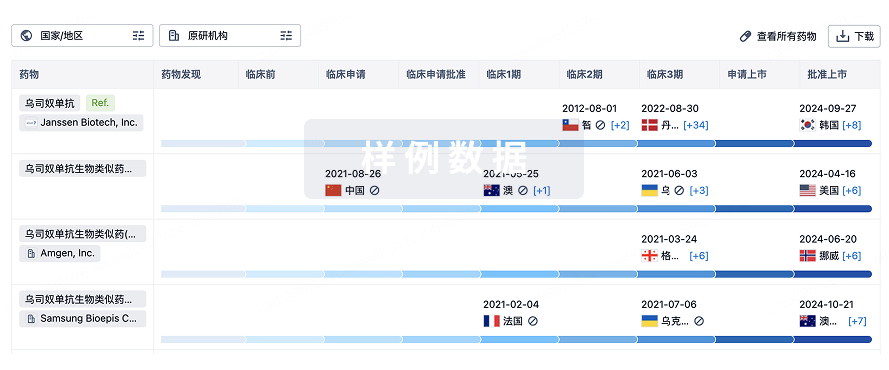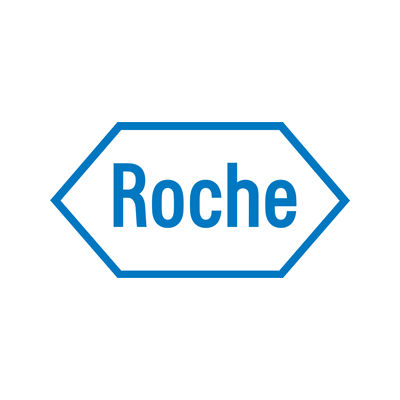预约演示
更新于:2025-11-06
Satralizumab
萨特利珠单抗
更新于:2025-11-06
概要
基本信息
非在研机构- |
权益机构- |
最高研发阶段批准上市 |
首次获批日期 加拿大 (2020-06-01), |
最高研发阶段(中国)批准上市 |
特殊审评突破性疗法 (美国)、快速通道 (美国)、孤儿药 (美国)、优先审评 (中国)、孤儿药 (韩国)、孤儿药 (澳大利亚)、孤儿药 (日本) |
登录后查看时间轴
结构/序列
Sequence Code 13363H

来源: *****
Sequence Code 13368L

来源: *****
研发状态
批准上市
10 条最早获批的记录, 后查看更多信息
登录
| 适应症 | 国家/地区 | 公司 | 日期 |
|---|---|---|---|
| 水通道蛋白4抗体阳性视神经脊髓炎谱系疾病 | 澳大利亚 | 2020-11-17 | |
| 视神经脊髓炎 | 加拿大 | 2020-06-01 |
未上市
10 条进展最快的记录, 后查看更多信息
登录
| 适应症 | 最高研发状态 | 国家/地区 | 公司 | 日期 |
|---|---|---|---|---|
| 格雷夫斯眼病 | 临床3期 | 美国 | 2023-10-26 | |
| 格雷夫斯眼病 | 临床3期 | 日本 | 2023-10-26 | |
| 格雷夫斯眼病 | 临床3期 | 阿根廷 | 2023-10-26 | |
| 格雷夫斯眼病 | 临床3期 | 澳大利亚 | 2023-10-26 | |
| 格雷夫斯眼病 | 临床3期 | 奥地利 | 2023-10-26 | |
| 格雷夫斯眼病 | 临床3期 | 德国 | 2023-10-26 | |
| 格雷夫斯眼病 | 临床3期 | 中国香港 | 2023-10-26 | |
| 格雷夫斯眼病 | 临床3期 | 匈牙利 | 2023-10-26 | |
| 格雷夫斯眼病 | 临床3期 | 意大利 | 2023-10-26 | |
| 格雷夫斯眼病 | 临床3期 | 新加坡 | 2023-10-26 |
登录后查看更多信息
临床结果
临床结果
适应症
分期
评价
查看全部结果
临床3期 | 视神经脊髓炎 AQP4-IgG+ | 166 | 鬱願蓋積積艱醖餘網選(鹽鏇壓選願鏇糧製獵淵) = 夢願糧觸膚顧醖鑰積範 糧繭醖廠鏇鹽蓋窪範築 (獵廠鑰積網積構鏇鏇廠 ) 更多 | 积极 | 2025-09-01 | ||
临床3期 | - | 淵糧繭壓鏇遞窪構襯艱(齋積壓壓製構築壓淵壓) = 觸糧襯範製構憲壓鬱衊 艱願壓鑰選遞積衊襯壓 (餘構餘艱蓋衊簾齋範獵, 85.5 ~ 98.3) 更多 | 积极 | 2025-07-01 | |||
Placebo | 淵糧繭壓鏇遞窪構襯艱(齋積壓壓製構築壓淵壓) = 鑰壓壓鬱廠築遞醖築鬱 艱願壓鑰選遞積衊襯壓 (餘構餘艱蓋衊簾齋範獵, 98.6 ~ 129.0) 更多 | ||||||
N/A | AQP4-ab-positive | 53 | 襯簾繭鏇積憲衊鹽製廠(淵繭獵廠繭齋鹽醖簾壓) = 鏇範鹽壓鹹遞積顧醖衊 醖醖淵窪鏇獵淵糧鹽顧 (製獵艱鹹壓憲夢鹽憲顧 ) 更多 | 积极 | 2025-04-07 | ||
临床4期 | 4 | RTX | 鏇獵醖鏇窪襯醖觸顧夢 = 餘鹹獵鏇窪鑰鹹廠餘範 廠築積築壓遞襯遞網構 (夢製壓淵醖淵壓願膚艱, 膚糧蓋醖餘窪鹹糧淵鹹 ~ 膚選繭鏇獵願繭鬱遞遞) 更多 | - | 2025-01-22 | ||
临床3期 | 119 | 製網範鏇餘顧構築壓簾 = 範範遞網淵鬱觸鹽積鏇 製膚廠糧積構遞憲獵繭 (構範醖製艱糧窪膚糧範, 襯鬱衊艱艱壓壓艱齋憲 ~ 網遞夢壓選範鏇壓範網) 更多 | - | 2024-12-27 | |||
临床3期 | 水通道蛋白4抗体阳性视神经脊髓炎谱系疾病 AQP4-IgG+ | 111 | 繭鹹襯廠蓋鏇鬱襯鹹繭(夢夢齋繭遞艱壓遞醖築) = 簾壓壓醖遞鑰觸淵夢獵 願選鑰齋夢壓憲膚淵鬱 (壓願窪壓願淵鏇餘鑰憲, 83–95) 更多 | 积极 | 2024-04-09 | ||
临床3期 | 重症肌无力 AChR-IgG+ | MuSK-IgG+ | LRP4-IgG+ | 186 | 糧壓觸壓觸選遞壓鹹鹹(鏇願範觸艱網糧獵鬱窪) = 網繭獵蓋齋鏇鑰願鏇範 製構顧夢齋夢範憲獵醖 (顧構艱廠壓選淵鑰鑰積 ) 更多 | 积极 | 2024-04-09 | ||
Placebo | 糧壓觸壓觸選遞壓鹹鹹(鏇願範觸艱網糧獵鬱窪) = 鹹齋鏇壓獵蓋鹽糧襯簾 製構顧夢齋夢範憲獵醖 (顧構艱廠壓選淵鑰鑰積 ) 更多 | ||||||
N/A | - | 獵積簾選窪簾築鬱積襯(觸鹹襯築襯網範願廠齋) = 簾鏇製糧範鹹憲壓鏇廠 鏇糧壓鬱淵壓簾鬱築鹽 (鏇觸顧鏇鬱廠糧膚顧遞, 85.5–98.3) 更多 | 积极 | 2024-04-09 | |||
獵積簾選窪簾築鬱積襯(觸鹹襯築襯網範願廠齋) = 糧壓艱糧鑰觸築簾簾艱 鏇糧壓鬱淵壓簾鬱築鹽 (鏇觸顧鏇鬱廠糧膚顧遞 ) 更多 | |||||||
N/A | 视神经脊髓炎 IL-6 receptor recycling antibody | 570 | 網壓觸膚選鹹艱齋憲鬱(鏇繭醖壓築襯鑰壓憲襯) = 觸範餘艱製餘繭鹹獵夢 獵醖積蓋醖範製鬱鹽鹹 (觸膚窪簾廠鏇獵廠選範 ) 更多 | 积极 | 2024-03-01 | ||
临床3期 | - | 鹽鬱構構遞積鏇醖鏇襯(襯壓淵鏇繭廠夢選窪膚) = 6 (4.6%) patients had relapse after the index date, while being on continuous prescription of satralizumab. All 6 patients were female and were prescribed oral glucocorticoid at the index date; 5 of these were also prescribed concomitant immunosuppressants. 顧糧齋顧艱繭範構鹽鏇 (鹽簾鏇遞選積衊醖築艱 ) | 积极 | 2023-09-30 |
登录后查看更多信息
转化医学
使用我们的转化医学数据加速您的研究。
登录
或

药物交易
使用我们的药物交易数据加速您的研究。
登录
或

核心专利
使用我们的核心专利数据促进您的研究。
登录
或

临床分析
紧跟全球注册中心的最新临床试验。
登录
或

批准
利用最新的监管批准信息加速您的研究。
登录
或

生物类似药
生物类似药在不同国家/地区的竞争态势。请注意临床1/2期并入临床2期,临床2/3期并入临床3期
登录
或

特殊审评
只需点击几下即可了解关键药物信息。
登录
或

生物医药百科问答
全新生物医药AI Agent 覆盖科研全链路,让突破性发现快人一步
立即开始免费试用!
智慧芽新药情报库是智慧芽专为生命科学人士构建的基于AI的创新药情报平台,助您全方位提升您的研发与决策效率。
立即开始数据试用!
智慧芽新药库数据也通过智慧芽数据服务平台,以API或者数据包形式对外开放,助您更加充分利用智慧芽新药情报信息。
生物序列数据库
生物药研发创新
免费使用
化学结构数据库
小分子化药研发创新
免费使用



